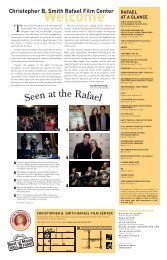2009 Souvenir Program Guide - California Film Institute
2009 Souvenir Program Guide - California Film Institute
2009 Souvenir Program Guide - California Film Institute
You also want an ePaper? Increase the reach of your titles
YUMPU automatically turns print PDFs into web optimized ePapers that Google loves.
MIROIR…MYSTÈRE…MAGIQUE<br />
by Karen Davis<br />
SNAPSHOT: ONSCREEN<br />
Vivre sa vie (1962): A young woman<br />
sits in a darkened movie theater<br />
alone, raising her gaze to the image<br />
onscreen of another young woman<br />
(Maria Falconetti, in Carl Theodor<br />
Dreyer’s 1928 silent masterwork,<br />
The Passion of Joan of Arc) who, in<br />
turn, lifts her eyes to meet those of<br />
an off-screen presence as she pleads<br />
for her right to be free. Both women<br />
mirror each other’s emotions, their<br />
radiant faces shining with tears, their<br />
expressive eyes reflecting beauty,<br />
suffering and an all-encompassing<br />
empathy.<br />
The young woman, alone in the<br />
theater, is “Nana”—no one in<br />
particular, a character whose name<br />
is French slang for “just a girl.” A<br />
mystery. A cipher. Starring in Jean-<br />
Luc Godard’s 1962 New Wave chef<br />
d’oeuvre Vivre sa vie is actress Anna<br />
LE PETIT SOLDAT<br />
Karina—but, as “Nana,” she is also<br />
you, me and everyone who has ever been moved to tears by the<br />
power of cinema; a projection of our most powerful dreams and<br />
strongest desires, our wish to be free.<br />
This is just one of the thousands of image-snapshots refl ecting the<br />
brilliance of an actor, a star, who can inhabit such a role, as “no one in<br />
particular,” while crafting one of the most memorable cinematic<br />
performances of our time. Anna Karina: a mirror, a mystery, blessed<br />
with ineffable magic that is palpable, and timeless.<br />
SNAPSHOT: OFF-SCREEN<br />
Born and raised in Denmark, Anna Karina (née Hanne Karin Blarke<br />
Bayer) made her screen debut in 1959, when Danish fi lmmaker Ib<br />
Schmedes discovered her, quite literally, singing and dancing in the<br />
streets to her own rhythm. Schmedes’ 11-minute fi lm, Pigen og Skoene<br />
(The Girl with the Shoes), garnered the Best Short <strong>Film</strong> award at<br />
Cannes and launched Karina’s career.<br />
But life was not a Hollywood musical by any means. To escape a<br />
diffi cult family situation, she moved to Paris at 18. Speaking no French,<br />
72<br />
ANNA KARINA<br />
Anna sought shelter at the Danish Church on the Champs-Élysées.<br />
She found work wherever she could: elevator girl, spare-change<br />
street-art painter. Then, the fi rst of several lucky coups de foudre<br />
struck: an introduction to Coco Chanel (who bestowed the name<br />
“Anna Karina” upon her), followed by a smashingly successful career<br />
as a top Parisian model.<br />
But Anna held fast to a girlhood dream to act. Again she struck out<br />
on her own, until another coup de foudre: Jean-Luc Godard, famed fi lm<br />
critic, director, enfant terrible and Karina’s soon-to-be husband (now<br />
ex-mari) spotted her in a soap commercial. In the fi lms and years that<br />
followed, the magical Karina/Godard collaboration became an<br />
internationally recognized beacon of 20th-century French culture,<br />
and a benchmark for world cinema at large.<br />
Generally acknowledged as the muse for Godard’s greatest work, Anna<br />
starred in several of his seminal fi lms, including Le petit soldat (1960),<br />
Une femme est une femme/A Woman Is a Woman (1961), which garnered<br />
Karina the Best Actress award at the Berlin <strong>Film</strong> Festival, Vivre sa vie/My<br />
Life to Live (1962), Bande à part/Band of Outsiders (1964), Alphaville<br />
mvff.com




